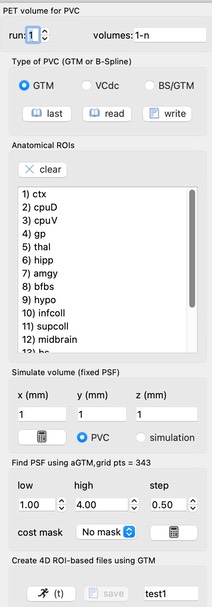
PET typically has low anatomical resolution, which is a function of the physics of the technique but also generally is required by low counting statistics (larger voxels provide more counts). Partial volume correction (PVC) techniques compensate for some aspects of low resolution by correcting for spillover between regions.
Fastmap currently implements three types of PVC:
- Conventional geometric transfer matrix (GTM) approach based upon anatomically defined regions, typically obtained from MRI-based subject-specific segmentation (e.g., freeSurfer) or from a multi-subject atlas following spatial normalization. To define a GTM model, select a series of overlays from the predefine list in fastmap BEFORE entering the PVC module. To save a GTM, write the model to a saved file to be retrieved for use on other subjects. GTM in principle can fully recover regional crosstalk, but somewhat different results can be obtained depending upon region selections.
- Reblurred Van Cittert deconvolution (VCdc) is a simple and fast interactive deconvolution method that can be used on any matrix size and does not require any anatomical segmentation. This method is popular among PET vendors for obvious reasons. It does not recover regional crosstalk as well as GTM.
- B-spline GTM is a method developed within fastmap by the author that applies the standard GTM formalism using automatically generated b-spline basis functions. It does not require any anatomical segmentation. It is best implemented within a standardized space, which enables reuse of the calculated GTM matrix that is saved in the model file. Like standard GTM, this is an ROI-based method, but the use of b-spline basis functions enables image formation following PVC. This method accomplishes both spatial smoothing and PVC in one step.